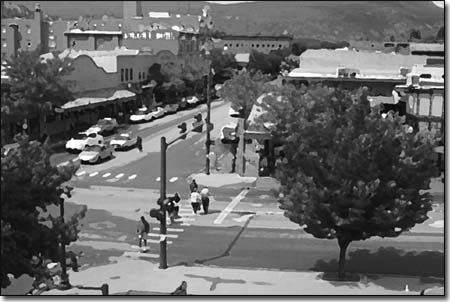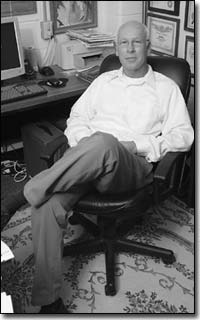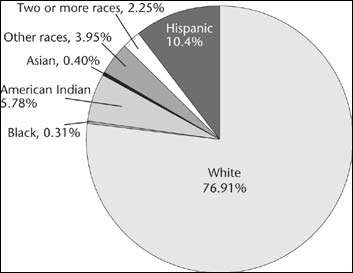|
 |
|
Although on the surface it may
look idyllic, Durango, home to large Latino, white and
American Indian populations, has its fair share
of racial tension and discrimination. However, in recent
months members of various community groups as well as
Fort Lewis College,
the Durango City Council and Durango School District
9-R have stepped up efforts to address the problem. Many
say the probelm
stems from misconceptions and a lack of education and
understanding./Photo by Todd Newcomer. |
Plenty of anecdotes from minorities expose racial discrimination in
La Plata County. While these anecdotes paint a picture
of struggle, organizations working to combat the problem paint a picture
of hope.
In recent months, members of various community groups have stepped up
their efforts to address discrimination by vowing to educate residents
about the need for cultural tolerance and sensitivity. When the Rocky
Mountain Region of the U.S. Civil Rights Commission held a public hearing
in Durango last spring, residents described a multitude of discrimination
issues that eventually led commissioners to urge community leaders to
get proactive. Commissioners feel such issues are best addressed on a
local level so they left with a message: Get going.
John Dulles, director of the Civil Rights Commission, says his board
only wants to act in an advisory capacity instead of forcing out-of-area
mandates on local residents. He's hopeful that county leaders will remain
responsive.
"The discrimination issues still exist since we visited, but I had a
sense of good strong leadership in the community. There are many people
doing excellent work," Dulles says.
Achieving diversity on campus
Along with the federal commission, the Colorado Civil Rights Commission
is also providing local community leaders with guidance. The state commission
is working especially close with Fort Lewis College, a target of claims
by American Indian students. For at least a decade, these minority students
have reported to commissioners that they feel unfairly treated in a variety
of ways, including lack of available housing and bungled health care.
Because these particular issues keep arising, Wendell Pryor, director
of the state Civil Rights Commission, says he continues to have an "ongoing
interest" in achieving diversity on campus.
 |
Dave Eppich, assistant to the
president at Fort
Lewis College, said the college is working on ways
to communicate better with its American Indian
students on issues of health care and
housing./Photo by Todd Newcomer. |
In recent months, state civil rights commissioners have met with college
officials to identify solutions. Dave Eppich, assistant to the president
of external affairs, says that the college is working with federal housing
agencies to identify funding to replace the dilapidated student family
housing the college demolished four years ago. At the time of the demolition,
American Indian students were upset that a housing option for the families
was being taken away. They worried they were being unreasonably locked
out.
Eppich says the students were immediately placed in single student housing
on campus - an option that remains for American Indian student families
to this day.
"Eleven families lived in single student housing during the winter semester
and of those, nine were American Indian families," Eppich says.
Eppich adds that the college recognizes the need to replace the family
housing, but receiving federal money for construction on state property
is especially cumbersome. Still, he says the college is acting at the
behest of the state commission to continue researching options.
The college is also increasing ways to communicate with American Indian
students about how to receive medical treatment in the community. The
setup is somewhat unique because American Indian students from any tribe
may attend FLC without charge. However, they are obligated to pay student
fees, one of which goes to fund the college's on-campus health-care clinic.
Eppich says in the past, there has been miscommunication about how the
clinic operates and what American Indian students are required to do
to get proper health care and be reimbursed by their tribes for any charges.
"It's largely been a matter of miscommunication," Eppich explains. "The
students come here and don't realize what they need to do in some cases,
and they end up getting caught in a bureaucratic entanglement."
This year, the college is providing American Indian students with more
and better information on how the college runs the health-care clinic
and how those operations interact with their own tribes. The increased
communication and information flow is what Eppich sees as an important
but simple fix.
"I think the most important thing to realize with discrimination issues
is that we have to understand what peoples' perceptions are," he adds. "What's
perceived is not always reality."
Teaching tolerance
Perceptions and understanding are also vital to organizations working
in area school districts. Durango School District 9-R, which some residents
often charge as not providing adequate or fair education for Hispanics
has a long checklist of actions it will or continues to take to tackle
discrimination.
Such actions include holding focus groups and youth summits, enforcing
safety, and building skills of teachers so they are better able to handle
bullying and racism. New for this school year will be the district's
Task Force on Minority Student Achievement. Deb Uroda, district public
information officer, explains that though the task force will focus primarily
on improving achievement of Hispanic students, it also will make aim
to curb racial intimidation so Hispanic students feel safe and welcome
at school.
 District leaders have also embraced a working relationship with the
4 Corners Safe Schools Coalition, a nonprofit community group. The coalition
formed in 2002, shortly after a Farmington man fatally beat Fred Martinez,
a transgendered Cortez teen-ager. Martinez' identity was a key factor
in the incident and became a key issue for surrounding communities to
study. Organizations and activists pleaded with community leaders to
get involved in teaching tolerance. District leaders have also embraced a working relationship with the
4 Corners Safe Schools Coalition, a nonprofit community group. The coalition
formed in 2002, shortly after a Farmington man fatally beat Fred Martinez,
a transgendered Cortez teen-ager. Martinez' identity was a key factor
in the incident and became a key issue for surrounding communities to
study. Organizations and activists pleaded with community leaders to
get involved in teaching tolerance.
Since then, the 4 Corners Safe Schools Coalition (4cSSC) has been energetically
leading efforts to teach school students about the effects of bigotry
and harassment.
"We especially want the kids to know that in the long term, these things
can lead to violence," says Tecumseh Burnett, coalition director.
This fall, 4cSSC plans to conduct a pilot survey at Durango High School
to determine how students deal with discrimination. The coalition, Burnett
says, will use the results to instigate a series of student study 4 circles
in which students will discuss how discrimination affects themselves,
their peers and society.
In addition, Burnett says the coalition will continue to facilitate
nonviolent communication training for the community and students. This
training is based on models from the Center for Nonviolent Communication,
a global organization based on the research and solutions offered by
psychologist Marshall Rosenberg. Essentially, the center provides resources
for people to teach others how to communicate with compassion and resolve
conflicts nonviolently.
Opening minds
Community endeavors are not limited to educational institutions. Los
CompaF1eros, a local Hispanic advocacy group, continues to work on integrating
Hispanics into the larger community. Its most recent success came when
the Durango City Council agreed to adopt a resolution making the city
a "safe zone" so that legal and illegal immigrants can communicate with
the local government without fear of prejudice.
Corporal Dick Mullen, speaking for the La Plata County Sheriff's office,
says his department has not implemented any new programs to specifically
address racial profiling or intimidation at the county law level. He
only briefly stated that the sheriff's office continues to enforce and
advocate a long-term policy that prohibits such behavior and provides
measures for grievances if it does happen.
Yet, no matter how universal task forces, summits and policies are,
community leaders say that ultimately it's up to society, and especially
adults, to rid communities of discrimination.
Uroda says that addressing racism and intolerance in local schools is "never-ending." She
explains that each year school leaders deal with students from various
backgrounds and teachers with their histories and attitudes. Given that,
she says, racism won't disappear from schools until it disappears from
the community.
Pryor, director of the state's Civil Rights Commission, agrees. He says
the commission will soon approach city and county governments to enlist
their participation in the battle against racism.
That process may continue for many decades because of the rapid population
growth of La Plata County, says Sage Remington, a Southern Ute tribal
elder and activist.
Because La Plata County has a strong Hispanic heritage and two American
Indian reservations on its borders, there is a higher number of minorities
here compared to other similar small towns in the West. As more outsiders
make this area their home, they plant themselves in a milieu of cultural
significance. Some of them, Remington says, need to be active in educating
themselves and opening their minds.
"Some people bring their fortress with them when they move here," he
explains. "They don't see or take the time to understand the history
of these (minority) people, and so they keep their hearts locked and
their minds closed."
Ultimately, Burnett says, this is a similar purpose of the 4cSSC. The
only way the group can measure its success - and she believes this is
the same for other groups as well - is if they get students, parents
and community leaders involved in an ongoing and vigorous dialogue about
discrimination.
"Our main goal is to stir the pot and get that going."
|